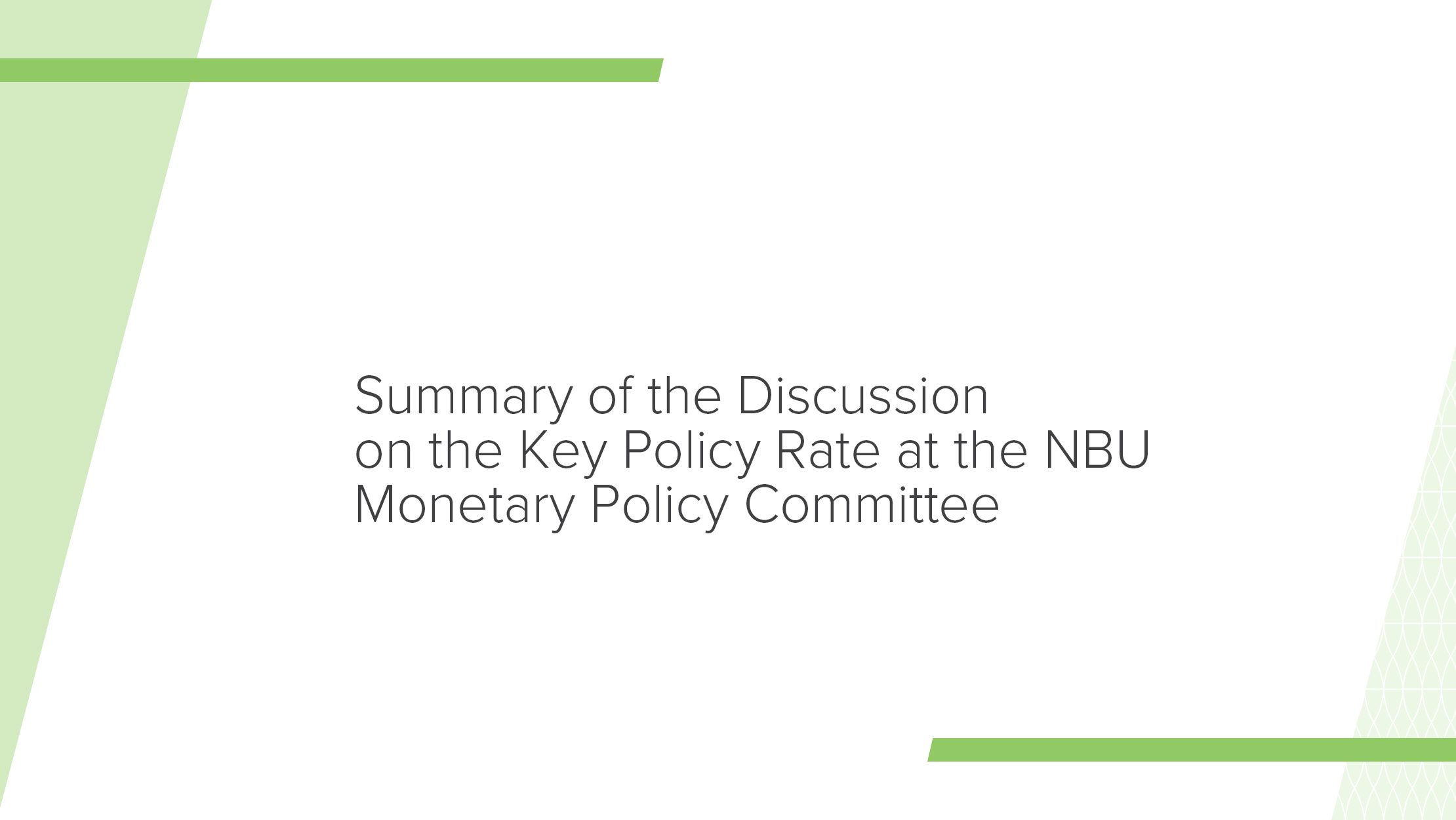Date of the meeting: 14 April 2021.
Attendees: all ten members of the Monetary Policy Committee (MPC) of the National Bank of Ukraine:
- Kyrylo Shevchenko, NBU Governor
- Kateryna Rozhkova, First Deputy Governor
- Yuriy Heletiy, Deputy Governor
- Yaroslav Matuzka, Deputy Governor
- Dmytro Sologub, Deputy Governor
- Oleksii Shaban, Deputy Governor
- Vitalii Vavryshchuk, Director of the Financial Stability Department
- Volodymyr Lepushynskyi, Director of the Monetary Policy and Economic Analysis Department
- Oleksii Lupin, Director of the Open Market Operations Department
- Yurii Polovniov, Director of the Statistics and Reporting Department.
During the meeting, the MPC members paid particular attention to the further increase in inflationary pressures, both external and domestic.
Inflation continued to accelerate faster than expected, the MPC members noted. Specifically, the CPI reached 8.5% yoy in March, which was significantly higher than the NBU’s January forecast of 7.6% yoy. On the one hand, inflationary pressures were largely driven by temporary external factors. In particular, global prices for fuel and food products remained higher than projected. On the other hand, higher core inflation suggests that underlying inflationary pressures also intensified significantly.
In addition, despite the further spread of COVID-19 and tighter quarantine measures in some regions, consumer demand continued to grow amid rising real incomes, including wages. This is evidenced by the strong performance of retail trade and car sales, higher output in the industrial sectors that supply goods to consumer markets (textiles, furniture, etc.), and more imports of consumer goods.
Inflation in Ukraine’s major trading partners also picked up. As a result, some central banks in these countries have already raised their key policy rates. These rate hikes have also been prompted by higher yields on U.S. Treasuries, which have lowered investor appetite for riskier assets.
Although Ukraine’s economic performance in Q1 was weaker than expected, it continued to recover, the MPC members pointed out. High commodity prices favored exporters, while sustained consumer demand was good for trade and services. Most businesses and household have adapted to working under quarantine restrictions, and so the latest waves of COVID-19 have not had the kind of devastating impact on the economy that they did last year. The Business Activity Expectations Index has exceeded the neutral level for the first time since the quarantine was imposed in 2020.
However, uncertainty over the duration and format of quarantine restrictions, among other things, is still holding back economic recovery. At the same time, the risks that the military conflict may escalate and that the review of the Stand-By program may continue to be delayed could lead to a worsening of exchange rate and inflation expectations.
The MPC members unanimously supported raising the key policy rate to 7.5% so that inflation can gradually slow and return to its target (5%) in H1 2022.
The higher-than-expected forecast inflation trajectory, elevated inflation expectations, and increased inflationary risks over the monetary policy horizon require a stronger response from the NBU, the MPC members agreed. An increase in the key policy rate above the January forecast will clearly signal to the market that the NBU intends to bring inflation back to its 5% target.
Most of the temporary shocks associated with higher fuel and food prices have already been priced in, meaning that their impact will diminish gradually, several MPC members pointed out. Meanwhile, a more sizable increase in the key policy rate will help ease underlying inflationary pressures.
The experience of 2017–2018, when the NBU raised the key policy rate, and 2019–2020, when it lowered it, shows that most deposit rates respond to these decisions with a certain lag. At the same time, the market’s response to the key policy rate hike in March 2021 indicates that the market is paying attention to the NBU’s signals. Specifically, most interest rates on deposits of various maturities stopped declining in early April, and some of them have edged higher.
The current increase in the key policy rate will boost the monetary transmission impulse through the interest rate channel. Initially, this will affect interbank rates and the corporate deposit rates offered by banks. Starting in mid-2021, the rate hike will be reflected in interest rates on retail deposits. This will shift some consumer demand toward bank deposits, easing the upward pressure that household consumption exerts on prices.
Retail deposits have markedly increased in recent months, as has consumer demand, one MPC member noted. This is partly due to a decline in spending on tourism and some services, which have become less accessible because of quarantine restrictions, this MPC member argued. The high liquidity surplus in the banking system is weakening the performance of the monetary transmission mechanism: banks are in no rush to raise interest rates to compete for deposits.
At the same time, the increase in the key policy rate will be positively perceived by the market, another MPC member said. Apart from the interest rate channel, the FX channel and the expectations channel also play an important role in monetary transmission. Stabilizing inflationary and exchange rate expectations and keeping them in check will help curb inflation and return it to its target.
Despite the key policy rate hike, the NBU’s monetary policy will remain accommodative, another MPC member said. Given the heightened inflation expectations, the neutral level of the key policy rate is currently 9%–9.5%. This implies that if the situation evolves according to the baseline scenario of the macroeconomic forecast, the NBU’s transition to a neutral monetary policy will take place only in late 2021 through early 2022. However, the baseline scenario assumes that cooperation with the IMF will resume in the summer and that the military conflict will not escalate, this MPC member emphasized.
The MPC members were divided over the projected trajectory of the key policy rate.
The decisions to raise the key policy rate in March and April were sufficient to bring inflation close to 5% in H1 2022, most MPC members agreed. The NBU’s resolute actions will help to gradually ease inflationary pressures and improve expectations, they said. A deescalation of hostilities is an important prerequisite for this scenario.
At the same time, inflationary pressures might be underestimated due to elevated uncertainty, several MPC members pointed out. The possibility of having to continue the cycle of key policy rate hikes cannot therefore be dismissed, these MPC members said.
The decision to set the key policy rate at 7.5% per annum was approved by the NBU Board at the monetary policy meeting held on 15 April 2021.
The Monetary Policy Committee (MPC) is an NBU advisory body that was created to share information and opinions on monetary policy formulation and implementation, in order to deliver price stability. The MPC comprises the NBU Governor, NBU Board members, and directors of the Monetary Policy and Economic Analysis, Open Market Operations, Financial Stability, and Statistics and Reporting Departments. The MPC meets the day before NBU Board meetings on monetary policy issues. Decisions on monetary policy issues are made by the NBU Board.


